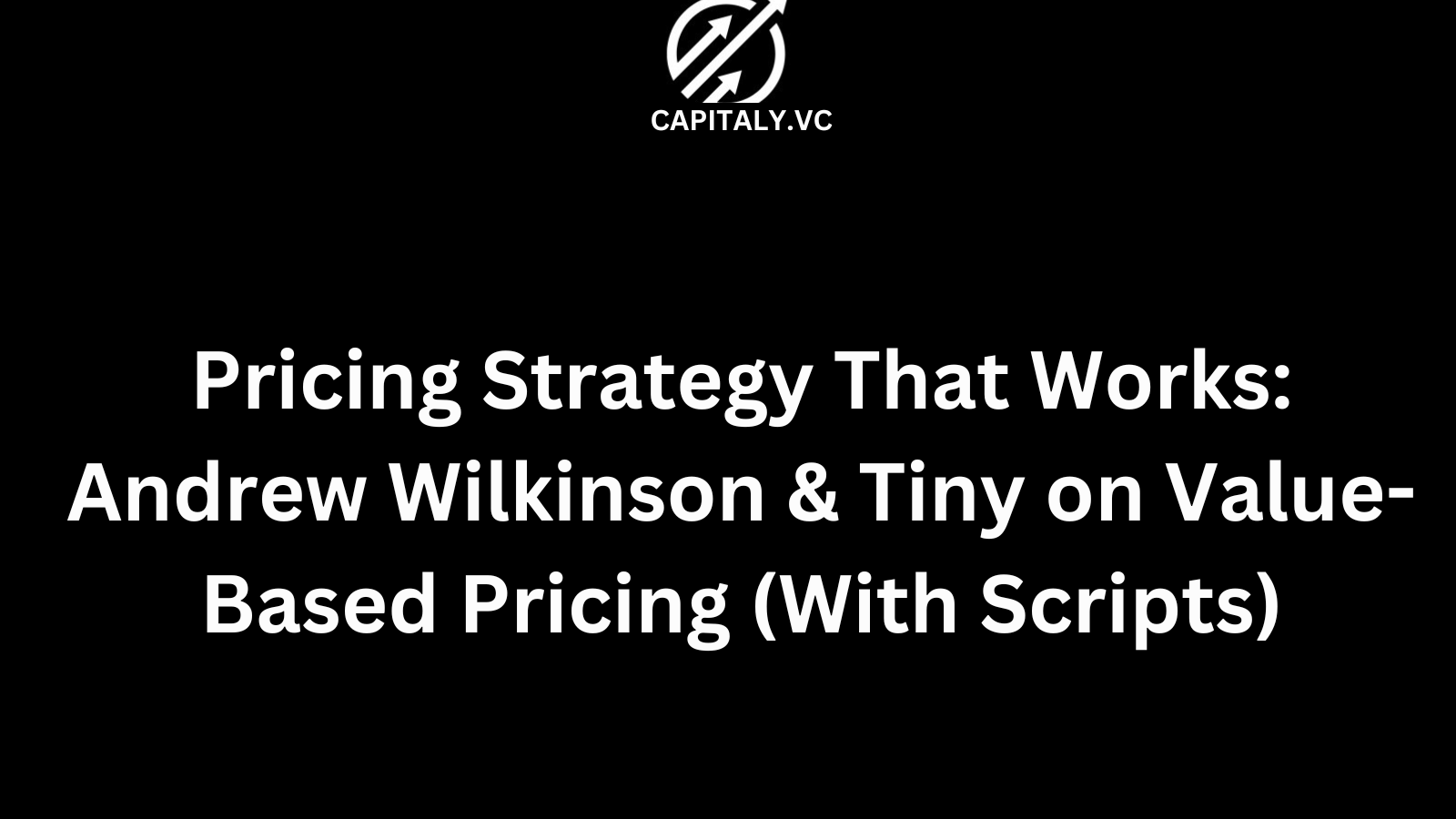Pricing Strategy That Works: Andrew Wilkinson & Tiny on Value-Based Pricing (With Scripts)
Pricing Strategy That Works: Andrew Wilkinson & Tiny on Value-Based Pricing (With Scripts)

Pricing Strategy That Works: Andrew Wilkinson & Tiny on Value-Based Pricing (With Scripts) is my plain-English playbook for charging more without losing the customer.
I’ll show you how to find the metric customers value, package it cleanly, and raise price with confidence.
I’ll give you copy-paste scripts for emails, calls, and procurement negotiations.
I’ll keep every sentence short, direct, and on its own line.

What “value-based pricing” really means
I price the outcome the customer cares about, not my costs or a competitor’s guess.
I tie price to the value metric that expands as value expands.
When customers win more, I earn more.
When to use value-based vs cost-plus vs competitor-based
I use value-based when outcomes are clear and measurable.
I use cost-plus for regulated or commodity inputs where value is hard to prove.
I use competitor-based only as a sanity check, never as a strategy.
The simple 3-step process I run every time
Step 1: Define the outcome in the customer’s words.
Step 2: Choose the value metric that maps cleanly to that outcome.
Step 3: Package and anchor with a price that earns ROI on day one.
Find your value metric without overthinking it
Pick the unit customers brag about after they buy.
For SaaS, think seats, usage, transactions, revenue processed, records protected.
For e-commerce, think refills, bundles, subscriptions, average order value.
For services, think deliverables, SLAs, time saved, leads booked.
Fast ways to learn willingness-to-pay
I ask five recent buyers, five lost deals, and five churned users the same questions.
I test two anchored price points on calls this week, not a month from now.
I send one “invoice test” to a tiny cohort before rolling anything wide.
For crisp interviews and emails, see our blog post: I Don’t Respond to Long Emails.
Package cleanly: Good / Better / Best that actually converts
Three tiers beat ten.
Good solves the job.
Better removes friction and adds a power feature.
Best is the executive version with priority support and analytics.
Put price fences between tiers so customers self-select without haggling.
Usage-based, seat-based, or hybrid
If value scales with activity, use usage.
If value scales with people, use seats.
If both matter, use a hybrid: a platform fee + metered overage.
Write the plan so finance can budget and never feel ambushed.
Anchoring that doesn’t feel manipulative
Show the Best tier first so Better feels reasonable.
Use a decoy only if it’s honest and helps customers choose faster.
Compare to the cost of the current pain in dollars and hours.
For storytelling that lands, see our blog post: Never Tell, Always Storytell.
Build a one-page ROI story
State the before in numbers.
Show the after in numbers.
Explain the mechanism that makes the lift repeatable.
End with payback in months, not a paragraph of adjectives.
Discounts that protect your price
Set a floor, a fence, and an expiry.
Floor: the lowest you’ll go.
Fence: who qualifies and why.
Expiry: when it ends.
No open-ended discounts.
No “friends and family” codes that live forever.
The price-increase playbook that keeps NRR ≥ 100%
Give 30 days notice for monthly and 60–90 for annual.
Grandfather core features and raise on new value.
Offer a short early-renewal window to lock in at a fair middle price.
Measure churn, downgrades, and expansion weekly for four weeks.
Scripts: announce a price change without drama
Email subject: Upcoming price update and new value on {date}
Body (copy-paste):
We’re updating pricing on {date}.
You’ll see an average change of {X%} tied to {new value/features/service level}.
Your current plan and core features remain.
If you renew by {early date}, we’ll lock you at {bridge price} for {term}.
Reply “Yes” and I’ll handle it for you.
Scripts: handle procurement like a calm adult
You: Our price reflects {outcome} and a {payback}-month payback.
Procurement: We need a discount.
You: Happy to discuss structure.
If we remove {premium features/support}, we can reduce the price by {X%}.
If you commit to {longer term/volume}, we can hold the full package at {price}.
You: Which option aligns with your goals.
Scripts: price on a sales call without blinking
You: Based on {seats/usage/outcome}, the plan is ${price}/month.
It replaces {current cost} and pays back in {months} months.
Prospect: That’s higher than we expected.
You: Totally fair.
If we pause {non-essential add-on}, it’s ${lower price} with the same ROI.
Do you want full or lean to start.
Enterprise vs SMB pricing in one minute
SMB buys speed and self-serve.
Enterprise buys risk reduction, governance, and integration.
Charge for security reviews, SSO, sandbox, priority SLAs, and procurement admin.
Make it a package, not a line-item war.
Freemium, trials, and conversions that don’t cannibalize
Freemium should prove the aha, not deliver the whole job.
Trials should be time-boxed with clear activation milestones.
Gate export, admin, or automation behind paid.
Follow up on day 2, 7, and 12 with a single call-to-action each time.
What I watch after any pricing change
Win rate on qualified deals.
NRR and GRR by cohort.
Time-to-value and time-to-first key action.
Discount rate by segment and rep.
If NRR ≥ 100% and win rate holds, keep going.
Rollout without a fire drill
Pilot with 5–10% of customers.
Turn on billing previews and usage alerts.
Publish a FAQ and upgrade path.
Collect three case studies before the wide launch.
Global and localization basics
Localize currency, tax, and payment methods first.
Price in psychologically round numbers for each market.
Keep feature parity and adjust support hours as value.
Avoid copy-pasting US pricing without context.
Avoid these pricing mistakes
Pricing the org chart, not the customer outcome.
Adding features to justify price instead of highlighting proof.
Raising price with no value metric the customer believes.
Permanent “sales” that train buyers to wait you out.
Copy-paste assets you can use today
One-line value narrative.
We charge for {value metric} because it scales with {outcome} you care about.
Plan names.
Starter.
Growth.
Scale.
(Short names beat cute ones.)
Pricing page bullets.
Outcome first.
Proof second.
Price third.
CTA last.
Internal approval note.
Goal: lift NRR to {target}% with minimal churn.
Guardrails: discount floor {X%}, term options {12/24/36}, no custom features.
Review: weekly dashboard for 4 weeks post-launch.
Sector-specific quick starts
SaaS.
Price per seat plus a usage band that matches value creation.
Add SSO, audit logs, and sandbox to the top tier.
For more SaaS tactics, see our blog post: Sell Your SaaS ($1M+ EBITDA) to Tiny.
E-commerce.
Use bundles, subscriptions, and refill cadence to monetize convenience.
Raise AOV with good-better-best kits and free shipping thresholds.
For inventory and seasonality math, see our blog post: Sell Your E-commerce Brand ($1M+ Profit).
Marketplaces.
Charge take rate on GMV plus pro tools for the supply side.
Add insurance/escrow to defend price and reduce leakage.
For liquidity metrics and price fences, see our blog post: Marketplace Exits: Network Effects and Liquidity.
Agencies.
Productize into packages with SLA and outcomes.
Charge for speed, seniority, and scope changes with clear fences.
For proposal tone and brevity, see our blog post: Never Tell, Always Storytell.
Pricing calculator outline you can build in an hour
Input seats/usage.
Input current cost of pain.
Compute time saved × hourly rate or revenue lift × margin.
Show payback and 12-month ROI side by side.
Make exportable to PDF for procurement.
FAQs
How often should I review pricing.
Quarterly for new sales and semi-annually for existing customers.
What’s a healthy discount rate.
Under 10% on average with clear fences for volume and term.
Will a price increase hurt churn.
If tied to new value and rolled out cleanly, NRR can still ≥ 100%.
How do I price when value is hard to measure.
Use a proxy metric customers trust and a money-back guarantee for the first cohort.
Should I show monthly and annual on the same page.
Yes, with annual highlighted and 2–3 months free equivalent.
Free trial or freemium.
Trial if activation is fast.
Freemium if habit is the moat.
What’s the fastest way to test a higher price.
Quote it on live calls to a small, qualified segment this week.
Do I need surveys.
They help, but won/lost interviews beat hypothetical answers.
How do I stop one big customer from anchoring my price.
Use custom packaging with price fences and tie price to value delivered.
How do I handle legacy plans.
Grandfather core, add new value, and move users at renewal with a bridge offer.
Conclusion
Pricing Strategy That Works: Andrew Wilkinson & Tiny on Value-Based Pricing (With Scripts) is about charging for the outcome, tying price to a value metric, and communicating with calm confidence.
Use the scripts, run a small pilot, and watch NRR rise without gimmicks.
Get Your Copy of Never Enough at https://www.neverenough.com/



.png)